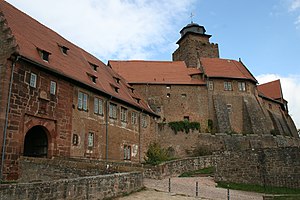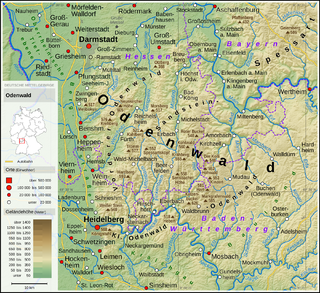
The Odenwald is a low mountain range in the German states of Hesse, Bavaria and Baden-Württemberg.

Seeheim-Jugenheim is a municipality in the Darmstadt-Dieburg district in Hesse, Germany. It has a population of approximately 17,000.

Zwingenberg lies in the Bergstraße district in southern Hessen, Germany, south of Frankfurt and Darmstadt, and with the granting of town rights coming in 1274 it is the oldest town on the Hessen Bergstraße.

The Bergstraße is 80-kilometre-long (50 mi) ancient trade route in the south-west of Germany. The route and the area around it is a mountainous "theme route" running north–south along the western edge of the Odenwald forest in southern Hesse and northern Baden-Württemberg. The route passes through the Bergstraße administrative district, and independent viticultural regions of Hessische Bergstraße and Badische Bergstraße. Between the cities of Heidelberg and Weinheim the Upper Rhine Railway Company (OEG) tram route runs alongside.

Balkhausen is a village of 693 inhabitants forming part of the municipality Seeheim-Jugenheim, Darmstadt-Dieburg district in Hesse, Germany.
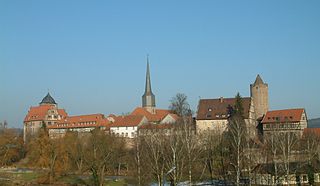
Schlitz is a small town in the Vogelsbergkreis in eastern Hesse, Germany.
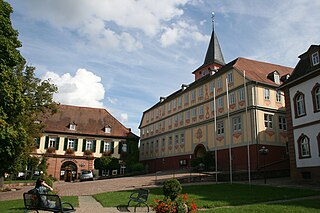
Bad König is a town and resort (Kurort) in the central Odenwald in the Odenwaldkreis (district) in Hesse, Germany, 29 km southeast of Darmstadt.
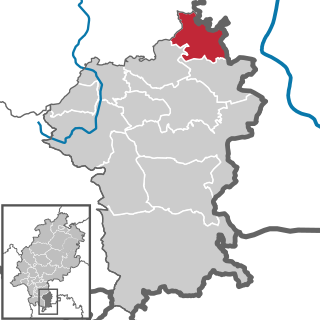
Breuberg is a town in the Odenwaldkreis district of Hesse, Germany. It is 28 km east of Darmstadt and 20 km southwest of Aschaffenburg.

Otzberg is a municipality in the district of Darmstadt-Dieburg, located in the Odenwald forest region of Germany. It was founded in 1972 by the merger of six former independent municipalities.

Frankenstein Castle is a hilltop castle in the Odenwald overlooking the city of Darmstadt in Germany. This castle may have been an inspiration for Mary Shelley when she wrote her 1818 Gothic novel Frankenstein; or, The Modern Prometheus.

Lautertal (Odenwald) is a municipality in the Bergstraße district in the Hessian Odenwald in Germany that came into being with the merger of several former communities.

Eberstadt is the southernmost borough of Darmstadt in Hessen, Germany with a population of 23,728.

The House of Franckenstein is the name of a feudal, Franconian noble family in Germany, descendants from the Dynasts of the Breuberg family; offsprings of the Lords of Lützelbach from Höchst im Odenwald.

Hessisches Landesmuseum Darmstadt (HLMD) is a large multidisciplinary museum in Darmstadt, Germany. The museum exhibits Rembrandt, Beuys, a primeval horse and a mastodon under the slogan "The whole world under one roof". As one of the oldest public museums in Germany, it has c. 80,000 visitors every year and a collection size of 1.35 million objects. Since 2019, Martin Faass has been director of the museum. It is one of the three Hessian State museums, in addition to the museums in Kassel and Wiesbaden. Similar institutions in Europe are the Universalmuseum Joanneum in Graz and the National Museum of Scotland in Edinburgh.

Schloss Heiligenberg is a castle to the east of Jugenheim, part of Seeheim-Jugenheim, about 12 kilometres to the south of Darmstadt, Germany. It is built on the Heiligenberg, with panoramic views of the Rhineland as far as the Palatinate. It is now the headquarters of the Amt für Lehrerbildung, though its 'Gartensaal' is occasionally used for concerts and art exhibitions.

Otzberg Castle in the German state of Hesse is a medieval castle on the summit of the Otzberg in the Odenwald forest at a height of 367 m above NN. On its northern slopes is the village of Hering, which grew out of the lower ward or castellan's settlement. The history of castle and village is therefore closely interwoven.

The Neckar-Odenwald Limes is a collective term for two, very different early sections of the Upper Germanic-Rhaetian Limes, a Roman defensive frontier line that may have been utilised during slightly different periods in history. The Neckar-Odenwald Limes consists of the northern Odenwald Limes (Odenwaldlimes), a cross-country limes with camps, watchtowers and palisades, which linked the River Main with the Neckar, and the adjoining southern Neckar Limes (Neckarlimes), which in earlier research was seen as a typical 'riverine limes', whereby the river replaced the function of the palisade as an approach obstacle. More recent research has thrown a different light on this way of viewing things that means may have to be relativized in future. The resulting research is ongoing.

The Pfungstadt Railway (Pfungstadtbahn) is a single-track branch line that branches off the Main-Neckar Railway in Darmstadt-Eberstadt and runs to a station on the eastern edge of the inner town of Pfungstadt, in Hesse, Germany.

The House of Breuberg is the name of a dynastic, franconian, noble family in Germany, descendants from the Lords of Lützelbach.

Friedrich Uhlhorn was an honorary professor at the Philipps-Universität Marburg, whose scientific focus was on the history of the State of Hesse and was also known for his work outside Hesse. His special scientific interest was mainly focused on the problems of historical cartography. In collaboration with Edmund Ernst Stengel, he published the Geschichtlichen Atlas von Hessen, which is considered his major work. He also wrote the article Die deutschen Territorien. A: The West, which deals with the West German regional history. Likewise he was responsible as editor for the Hessisches Jahrbuch für Landesgeschichte by Bruno Gebhardt.

